READ VALUE USING INTELLIGENT TESTER (INTAKE AIR TEMPERATURE)
READ VALUE USING INTELLIGENT TESTER (CHECK FOR OPEN IN WIRE HARNESS)
CHECK HARNESS AND CONNECTOR (INTAKE AIR TEMPERATURE SENSOR - ECM)
READ VALUE USING INTELLIGENT TESTER (CHECK FOR SHORT IN WIRE HARNESS)
CHECK HARNESS AND CONNECTOR (INTAKE AIR TEMPERATURE SENSOR - ECM)
CONFIRM GOOD CONNECTION TO SENSOR. IF OK, REPLACE INTAKE AIR TEMPERATURE SENSOR
REPAIR OR REPLACE HARNESS OR CONNECTOR
CONFIRM GOOD CONNECTION TO ECM. IF OK, REPLACE ECM.
REPLACE INTAKE AIR TEMPERATURE SENSOR
CONFIRM WHETHER MALFUNCTION HAS BEEN SUCCESSFULLY REPAIRED
DTC P0110 Intake Air Temperature Circuit |
DTC P0112 Intake Air Temperature Circuit Low Input |
DTC P0113 Intake Air Temperature Circuit High Input |
DESCRIPTION
- w/ MAF meter:
The Intake Air Temperature (IAT) sensor, built into the Mass Air Flow (MAF) meter, monitors the IAT. The IAT senor has a thermistor that varies its resistance depending on the temperature of the intake air. When the air temperature is low, the resistance in the thermistor increases. When the air temperature is high, the resistance decreases. The variations in resistance are communicated to the ECM as change in voltage (see Fig. 1). The IAT sensor is connected to the ECM. The 5 V power source voltage in the ECM is applied to the IAT sensor from terminal THA via resister R.
The resister R and the IAT sensor are connected in series. When the resistance value of the IAT sensor changes in accordance with changes in the IAT, the voltage at terminal THA also changes. Based on this signal, the ECM increases the fuel injection volume to improve the driveability during cold engine operation.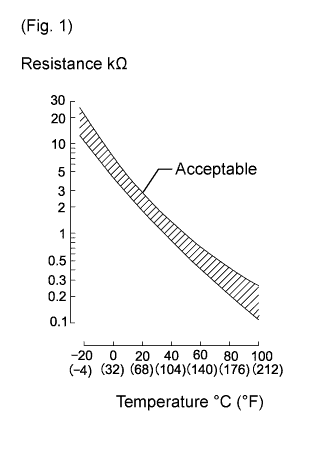
- w/o MAF meter:
The Intake Air Temperature (IAT) sensor, mounted on the air cleaner hose, monitors the IAT. The IAT sensor has a thermistor that varies its resistance depending on the temperature of the intake air. When the air temperature is low, the resistance in the thermistor increases. When the temperature is high, the resistance decreases. The variations in resistance are communicated to the ECM as changes in voltage (see Fig. 1).
The IAT sensor is connected to the ECM (see below). The 5 V power source voltage in the ECM is applied to the IAT sensor from terminal THA via resistor R.
The resistor R and the IAT sensor are connected in series. When the resistance value of the IAT sensor changes in accordance with changes in the IAT, the voltage at terminal THA also changes. Based on this signal, the ECM increases the fuel injection volume to improve the driveability during cold engine operation.
| DTC No. | DTC Detection Condition | Trouble Area |
| P0110 | Open or short in IAT sensor circuit for 0.5 seconds (1 trip detection logic) |
|
| P0112 | Short in IAT sensor circuit for 0.5 seconds (1 trip detection logic) |
|
| P0113 | Open in IAT sensor circuit for 0.5 seconds (1 trip detection logic) |
|
*2: w/o MAF meter
- HINT:
- When DTC P0110, P0112 or P0113 is detected, check the intake air temperature by entering the following menus on the intelligent tester: Powertrain / Engine / Data List / Intake Air.
| Temperature Displayed | Malfunction |
| -40°C (-40°F) | Open circuit |
| 140°C (284°F) or higher | Short circuit |
WIRING DIAGRAM
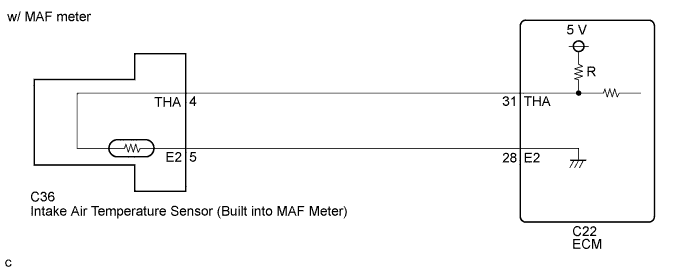
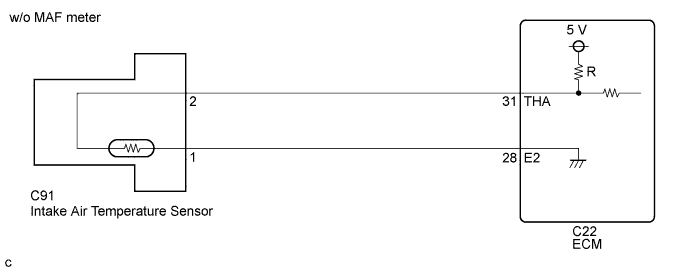
INSPECTION PROCEDURE
- NOTICE:
- After replacing the ECM, the new ECM needs registration (HILUX_TGN26 RM0000012XK05EX.html) and initialization (HILUX_TGN26 RM000000TIN04BX.html).
- HINT:
- Read freeze frame data using the intelligent tester. Freeze frame data records the engine condition when malfunctions are detected. When troubleshooting, freeze frame data can help determine if the vehicle was moving or stationary, if the engine was warmed up or not, and other data from the time the malfunction occurred.
| 1.READ VALUE USING INTELLIGENT TESTER (INTAKE AIR TEMPERATURE) |
Connect the intelligent tester to the DLC3.
Turn the ignition switch to ON and turn the tester on.
Enter the following menus: Powertrain / Engine and ECT / Data List / Intake Air.
Read the value.
- OK:
- Same as actual intake air temperature
Result Result Proceed to -40°C (-40°F) A 140°C (284°F) or higher B OK (same as actual intake air temperature) C - HINT:
- If there is an open circuit, the tester indicates -40°C (-40°F).
- If there is a short circuit, the tester indicates 140°C (284°F) or higher.
|
| ||||
|
| ||||
| A | |
| 2.READ VALUE USING INTELLIGENT TESTER (CHECK FOR OPEN IN WIRE HARNESS) |
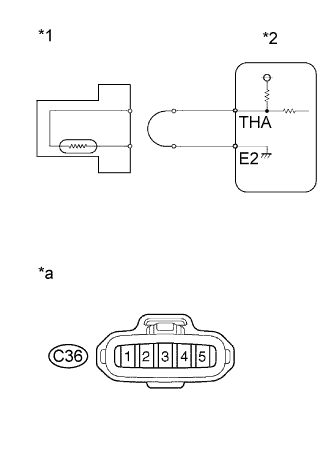 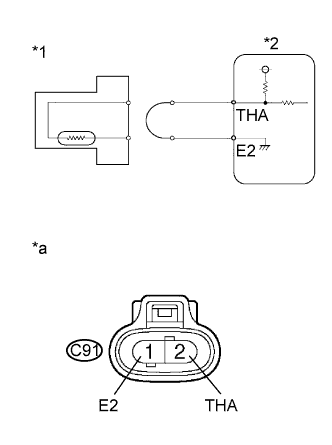 |
w/ mass air flow meter:
Disconnect the C36 mass air flow meter connector.
Connect terminals 4 and 5 of the mass air flow meter wire harness side connector.
Connect the intelligent tester to the DLC3.
Turn the ignition switch ON and turn the intelligent tester ON.
Enter the following menus: Powertrain / Engine / Data List / Intake Air.
Read the values.
- OK:
- 140°C (284°F) or more
Text in Illustration *1 Mass Air Flow Meter *2 ECM *a Front view of wire harness connector
(to Mass Air Flow Meter)
Reconnect the mass air flow meter connector.
w/o mass air flow meter:
Disconnect the C91 intake air temperature sensor connector.
Connect terminals 1 and 2 of the intake air temperature sensor wire harness side connector.
Connect the intelligent tester to the DLC3.
Turn the ignition switch ON and turn the intelligent tester ON.
Enter the following menus: Powertrain / Engine / Data List / Intake Air.
Read the values.
- OK:
- 140°C (284°F) or more
Text in Illustration *1 Intake Air Temperature Sensor *2 ECM *a Front view of wire harness connector
(to Intake Air Temperature Sensor)
Reconnect the intake air temperature sensor connector.
|
| ||||
|
| ||||
| 3.CHECK HARNESS AND CONNECTOR (INTAKE AIR TEMPERATURE SENSOR - ECM) |
w/ mass air flow meter:
Disconnect the mass air flow meter connector.
Disconnect the ECM connector.
Measure the resistance according to the value(s) in the table below.
- Standard Resistance:
w/ mass air flow meter Tester Connection Condition Specified Condition C36-4 (THA) - C22-31 (THA) Always Below 1 Ω C36-5 (E2) - C22-28 (E2) Always Below 1 Ω
Reconnect the mass air flow meter connector.
Reconnect the ECM connector.
w/o mass air flow meter:
Disconnect the intake air temperature sensor connector.
Disconnect the ECM connector.
Measure the resistance according to the value(s) in the table below.
w/o mass air flow meter Tester Connection Condition Specified Condition C91-2 - C22-31 (THA) Always Below 1 Ω C91-1 - C22-28 (E2) Always Below 1 Ω Reconnect the intake air temperature sensor connector.
Reconnect the ECM connector.
|
| ||||
|
| ||||
| 4.READ VALUE USING INTELLIGENT TESTER (CHECK FOR SHORT IN WIRE HARNESS) |
w/ mass air flow meter:
Disconnect the mass air flow meter connector.
Connect the intelligent tester to the DLC3.
Turn the ignition switch to ON and turn the tester on.
Enter the following menus: Powertrain / Engine and ECT / Data List / Intake Air.
Read the value.
- OK:
- -40°C (-40°F)
Text in Illustration *1 Mass Air Flow Meter *2 ECM Reconnect the mass air flow meter connector.
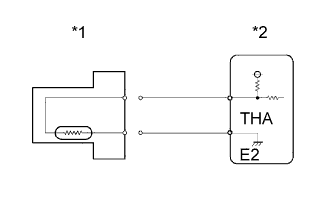 |
w/o mass air flow meter:
Disconnect the intake air temperature sensor connector.
Connect the intelligent tester to the DLC3.
Turn the ignition switch to ON and turn the tester on.
Enter the following menus: Powertrain / Engine and ECT / Data List / Intake Air.
Read the value.
- OK:
- -40°C (-40°F)
Text in Illustration *1 Intake Air Temperature Sensor *2 ECM Reconnect the intake air temperature sensor connector.
 |
|
| ||||
|
| ||||
| 5.CHECK HARNESS AND CONNECTOR (INTAKE AIR TEMPERATURE SENSOR - ECM) |
w/ mass air flow meter:
Disconnect the mass air flow meter connector.
Disconnect the ECM connector.
Measure the resistance according to the value(s) in the table below.
- Standard Resistance:
w/ mass air flow meter Tester Connection Condition Specified Condition C36-4 (THA) or C22-31 (THA) - Body ground Always 10 kΩ or higher
Reconnect the mass air flow meter connector.
Reconnect the ECM connector.
w/o mass air flow meter:
Disconnect the intake air temperature sensor connector.
Disconnect the ECM connector.
Measure the resistance according to the value(s) in the table below.
w/o mass air flow meter Tester Connection Condition Specified Condition C91-1 or C22-31 (THA) - Body ground Always 10 kΩ or higher Reconnect the intake air temperature sensor connector.
Reconnect the ECM connector.
|
| ||||
| OK | |
| 6.REPLACE ECM |
Replace the ECM (HILUX_TGN26 RM0000013Z001HX.html).
|
| ||||
| 7.CONFIRM GOOD CONNECTION TO SENSOR. IF OK, REPLACE INTAKE AIR TEMPERATURE SENSOR |
Replace the mass air flow meter (w/ mass air flow meter) (HILUX_TGN26 RM000000VHD041X.html).
Replace the intake air temperature sensor (w/o mass air flow meter) (HILUX_TGN26 RM0000014XP017X.html).
|
| ||||
| 8.REPAIR OR REPLACE HARNESS OR CONNECTOR |
Repair or replace the harness or connector.
|
| ||||
| 9.CONFIRM GOOD CONNECTION TO ECM. IF OK, REPLACE ECM. |
Replace the ECM (HILUX_TGN26 RM0000013Z001HX.html).
|
| ||||
| 10.REPLACE INTAKE AIR TEMPERATURE SENSOR |
Replace the mass air flow meter (w/ mass air flow meter) (HILUX_TGN26 RM000000VHD041X.html).
Replace the intake air temperature sensor (w/o mass air flow meter) (HILUX_TGN26 RM0000014XP017X.html).
| NEXT | |
| 11.CONFIRM WHETHER MALFUNCTION HAS BEEN SUCCESSFULLY REPAIRED |
Connect the intelligent tester to the DLC3.
Clear the DTCs (HILUX_TGN26 RM000000PDK0XEX.html).
Turn the ignition switch to ON for 1 second.
Enter the following menus: Powertrain / Engine and ECT / DTC.
Confirm that the DTC is not output again.
| NEXT | ||
| ||